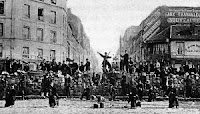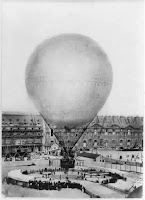Monday, April 18, 2011
History of Balloons
When I think of ballooning I imagine the colorful balloons with their wicker baskets floating over the vineyards of California's Sonoma and Napa counties. I've also seen them aloft during the annual Albuquerque International Balloon Fiesta in Albuquerque, New Mexico.
Balloons have served many purposes for nearly 200 years. The first known manned balloon flight was reportedly in 1783 in France. As with many new inventions their first application oftentimes had to do with military uses. Reports are that some were used on a very limited basis during the Napoleonic Wars. The first commonly recognized use of balloons as weapons however was in 1849 when the Austrian's launched them against Venice loaded with time fused bombs. The idea didn't work out too well since balloons are inherently subject to the wind and in this case the balloons floated back over the Austrians. The only other known use of balloons as bomb carriers was during World War II when the Japanese launched "Fire Balloons" against the U.S. West Coast. The balloon's incendiary devices were intended to start forest fires in the Pacific Northwest and set back our war efforts. What fires did result were quickly put out and the effort was ineffective. This could be considered the first inter-continental weapon. The picture to the left shows a shot down Japanese balloon reinflated by a group of Californians.
It became apparent both during the American Civil War and in World War I that a manned balloon could be effective as an observation vehicle to help pinpoint enemy positions. During the Civil War the Union Army launched balloons from both land and boats to search for Confederate forces. The army had troops assigned specifically for that purpose. The results were so-so. A balloon is hard to control and in one case a Union general almost landed on top of Confederate forces. Balloons were also employed during World War I to help spot enemy U-Boats.
The most amazing use of manned balloons was in 1870 Paris France during the Franco-Prussian War when the city was encircled by Prussian troops. This time was known as "The Siege of Paris" or sometimes referred to as the "Paris Commune". The Prussians had won the war, the French king was held captive in Prussia and the government of France surrendered but a large group of mostly leftist Parisians would not recognize the defeat and barricaded the city.
The Paris Commune lasted for many months. After weeks upon weeks of barricading Paris the city naturally ran out of provisions. Most animals were slaughtered for food including those in the Paris Zoo. The Prussians had the Parisians cut off from the rest of the world. The Prussians could have stormed the city but preferred not to for a variety of political reasons and pushed the French officials to put an end to it. Putting an end to the Paris Commune was not an easy thing to accomplish. The Prussians certainly didn't want to be responsible in the court of public opinion for a possible civilian massacre which probably would have resulted in storming the commune.
This is where the story of the balloon begins.
The people of Paris during the time of the Paris Commune were desperately trying to get word out to the rest of the world. But how would they do it? The answer was a gas filled balloon. Coal gas as opposed to hot-air was popular because the balloon could go further and higher. There were dangers however. A sharpshooter could hit the balloon exploding the coal gas. One good shot could do the trick. Other dangers were that the wind could cause the balloon to go out over the Atlantic and be lost which happened in two instances. In another case two passengers thought they were hopelessly lost over the ocean in fog but eventually came down in the snowy mountains of Norway. This inadvertently was the longest balloon ride to date. The balloon could also come down in Prussian held territory and the occupants captured. This also happened.
There were only seven balloons available in Paris and each one was in a varied state of condition. The first launch was successful and the rider traveled past the Prussian lines. The head of the French postal system then decided to use it for mail. Postage rates were set at about 20 cents per letter and a factory was converted to manufacture as many balloons as possible. The balloons were also used to transport a few important people out of the city and was successful.
Because the winds controlled balloons the trips out of Paris were one-way. To set up a "Pigeon Post" homing pigeons were taken on many flights so that there was a chance communications could be sent back to Paris. To help protect against Prussian sharpshooters the balloon launches were changed to night only, usually around midnight.
The balloon statistics during the weeks of the Paris Commune were:
66 balloons were launched
2 were lost at sea
6 were captured by the Prussians
102 passengers were carried
2,500,000 letters were carried
400 homing pigeons were carried
The Siege of Paris lasted four months and at the end the Prussians marched through Paris, charged the French with war reparations, held onto some French territory and left. That was the end of the Paris Commune which was never to reappear again. There is a very good book available for those wanting more detailed information on the Siege of Paris and the balloons, "The Fall of Paris" by author Alistaire Horne.
If you're thinking of a New Mexico vacation I would highly recommend attending the annual Albuquerque International Balloon Fiesta. This annual event is attended by people from throughout the world. The site below will give you dates and detailed information.
www.balloonfiesta.com
Below are sites for two excellent balloon museums worth a visit.
In Albuquerque, NM www.balloonmuseum.com
In Indianola, Iowa www.nationalballoonmuseum.com
Labels:
New Mexico,
Transportation







